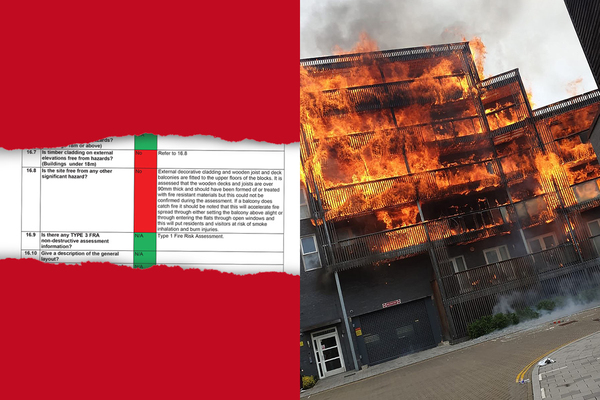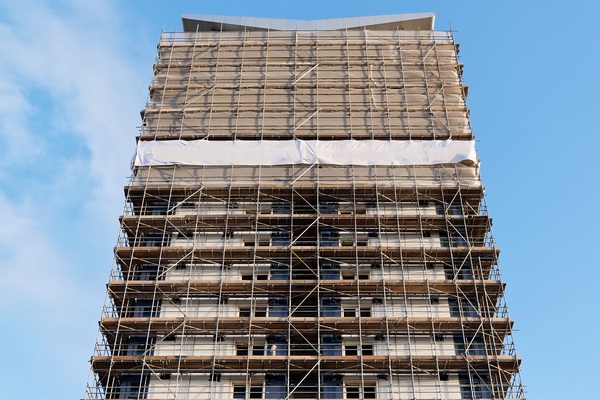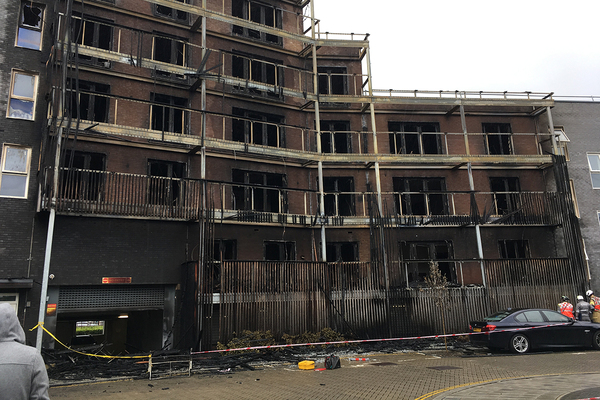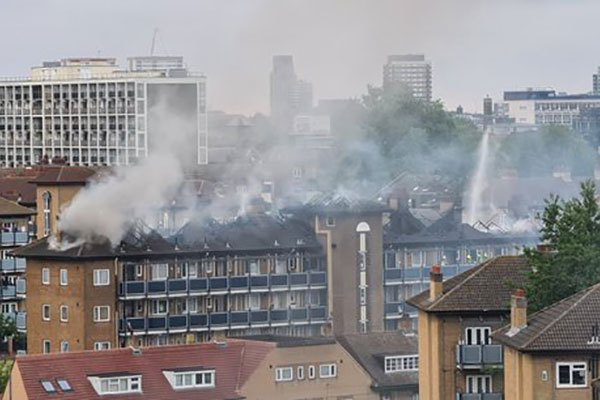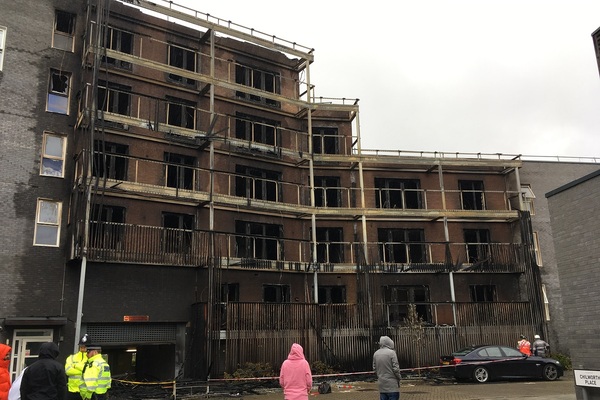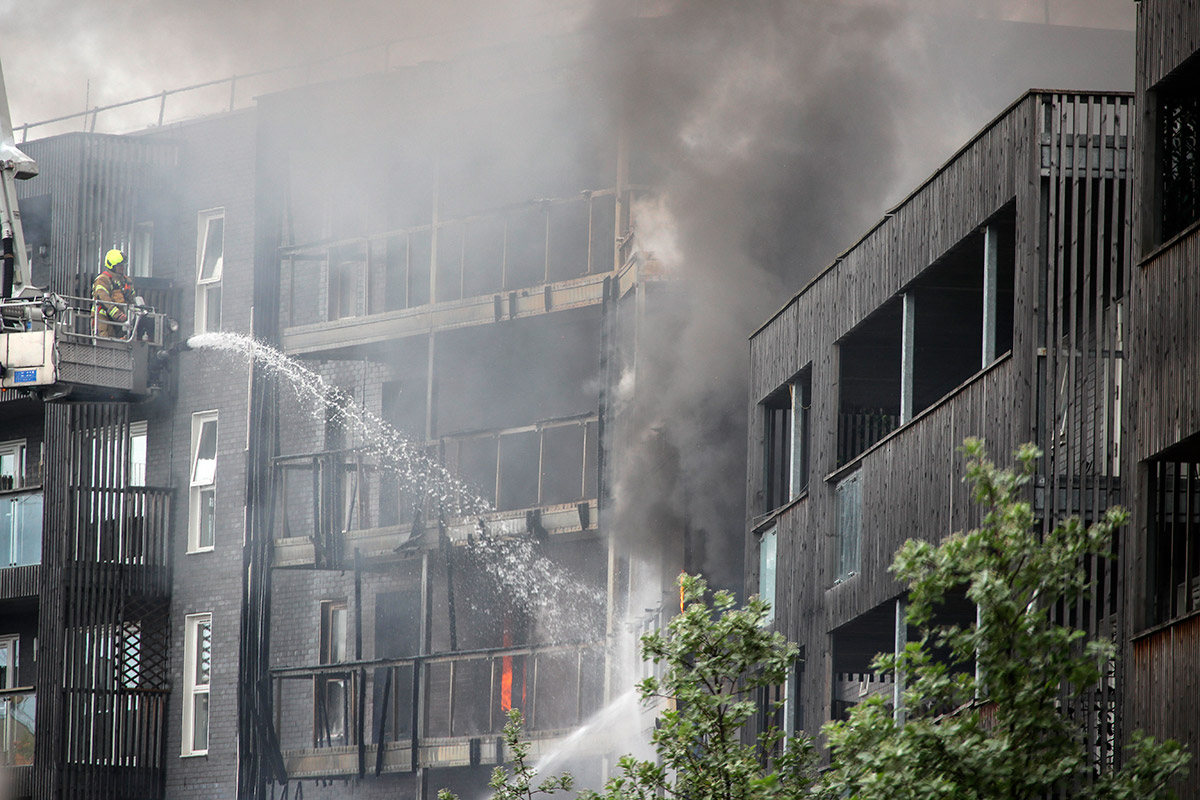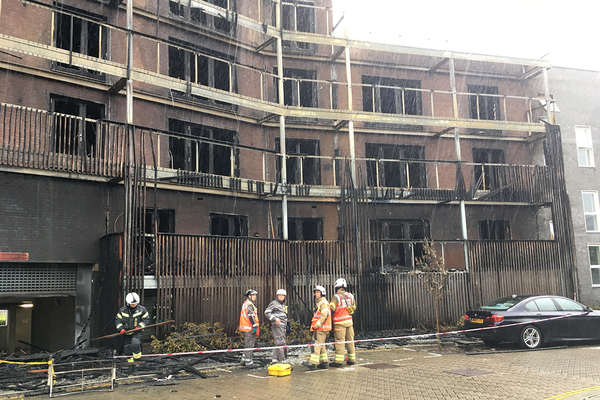Leaked Barking fire report reveals ‘significant risk to life’ from blaze
A devastating fire in Barking in June last year, which posed “a significant risk to life”, could have spread much more widely and was fuelled by a deadly combination of timber cladding and plastic mesh on balconies, a leaked expert report has revealed.
The fire ripped through Samuel Garside House, which led to 61 people evacuating their homes and two people being treated for smoke inhalation. The fire completely destroyed eight flats, whose residents have yet to return nearly a year after the fire.
Inside Housing has obtained a report by fire engineering firm Bureau Veritas for the London Fire Brigade (LFB) which looks into the fire at Samuel Garside House and reveals:
- Combustible timber cladding and black plastic mesh on the balconies created a combination of materials which “meant the fire from a tiny ignition could effect the entirety of the structure”.
- These materials likely breached the requirement of building guidance that the external should “not provide a medium for fire spread”, despite the building being lower than 18m.
- If the fire had been on the other side of the building it could have ripped through many more neighbouring properties as there was no separation between the timber to break its spread.
- An even bigger disaster was narrowly averted because a 19kg cylinder of propane gas stored on the roof wasn’t damaged by the fire.
Inside Housing revealed shortly after the blaze that the wood material used for the cladding and balconies at block was ThermoWood, a timber product that has a Class D fire rating.
However, tests carried out on the materials by Bureau Veritas after the fire found that the wood did not meet the criteria of a Class D fire rating, while the combination of the wood and plastic covering present did not even meet a Class E fire rating.
Anything rated under Class E is deemed “easily flammable” and can assist fire spread.
Included in the make-up of the balconies was a black plastic mesh, which the report said rapidly spread the fire horizontally and vertically, depositing considerable amounts of “flaming molten plastic droplets” and created “small pool fires” below.
It added: “The use of the black plastic netting with wood meant the fire from a tiny ignition could effect the entirety of the structure.”
The report also said the fire could have been much worse, revealing that a 19kg cylinder of propane was found in the roof of the building following the fire. This was not damaged by the fire.
It also said the fire spread would have been more devastating if it started on the opposite side of the building, where there was no separation between the timber on the balcony and the rest of the block.
It said if the fire had occurred on the “opposite side of the building, the combustibility of the materials could have allowed the fire to have spread along the entire west facing exterior… involving many more properties.”
Bellway, the developer of the block, told Inside Housing that work to remove the timber from Samuel Garside House and the neighbouring Ernest Websdale House had begun but was on pause due to the coronavirus crisis. Work is to resume on 11 May.
When Samuel Garside House was built, the official guidance – Approved Document B – required cladding materials to have a fire performance of at least Class B on buildings above 18m.
However, it set no standards for the combustibility of cladding below this height and balconies were widely believed to be exempt at any height – meaning Bellway and architects Sheppard Robson would likely have believed the design was in compliance with the guidance.
However the Bureau Veritas report concluded that the combination of materials was so combustible, it breached the performance standard in Approved Document B, which said the “external envelope of a building should not provide a medium for fire spread if it is likely to be a risk to health and safety”.
Bellway said that it could not comment on the findings of the LFB report as it had not received a copy. However, it refuted the claims that the building did not meet regulations and said the design and construction of the development complied with the guidance in Approved Document B (Fire Safety) as well as all other relevant guidance in British Standards.
In 2018, guidance was toughened to ban combustible materials for the external walls of buildings above 18m altogether. Following a consultation, this threshold is likely to be lowered to 11m later this month.
There are currently dozens of other blocks and houses across the Barking Riverside development which contain the same or similar wooden cladding and balconies.
A letter from Barking Riverside Limited, the L&Q and Greater London Authority joint venture which owns the Barking Riverside site, to residents in February said that it was looking at options to improve the fire safety on buildings across the development.
The letter, which was titled “update on exterior timber”, said that every building would receive a new independent fire safety report, with any work being started in the autumn at no cost to residents.
Before photo of Samuel Garside House (the Barking fire property) from property listings website shows the extent of the timber used on the balconies pic.twitter.com/zL0QMgX59O
— Peter Apps (@PeteApps)Before photo of Samuel Garside House (the Barking fire property) from property listings website shows the extent of the timber used on the balconies pic.twitter.com/zL0QMgX59O
— Peter Apps (@PeteApps) June 10, 2019
Responding to the LFB report, Pete Mason, chair of the Barking Reach Residents Association, said: “Landlords and managing agents had two years since Grenfell to inspect and make good the balconies and cladding throughout the estate and did not.
“We feel all the parties and landlords involved failed to make sure the properties were safe and endangered lives.”
Jonathan Evans, chief executive of cladding company Ash and Lacy and fire safety expert, said the report shows that timber used in construction might be more dangerous than previously thought, adding that the Barking fire adds support to the need for the combustibles ban to be brought to any building over 11m.
He said: “Samuel Garside is significant as it suffered a catastrophic fire, but being under 18m its construction would currently still be possible.
“If the combustible ban were to drop to 11m, then this building with these materials would have become impossible."
A spokesperson for Bellway said: "As a responsible developer Bellway has worked extremely hard at Barking Riverside to understand and respond to the concerns of the building owners, residents and other key partners.
"We have not received a copy of London Fire Brigade’s report into the fire so cannot comment on the findings at this time but this is not a case of non-compliance.
"We can confirm that the design and construction of the development complied with the guidance in Approved Document B (Fire Safety) as well as all other relevant guidance in British Standards.
"Works to all 70 apartments is now complete, with the final phase of ‘balcony works‘ suspended due to COVID-19, these works are now planned to restart on 11th May.
"Interim fire safety measures have been in place, such as simultaneous evacuation strategy, audible alarms and waking watch, to ensure the continued safety of residents until such time as the work is completed."
A London Fire Brigade spokesperson said: “Following the blaze in De Pass Gardens, our fire safety inspectors worked closely with the responsible person who put in place temporary safety measures, including waking watches and restrictions on balcony usage as well as the installation of common alarm systems.”
What the Bureau Veritas report said
- The combination of materials in the balconies did not show any significant fire resistance to the ignition of a relatively small fire
- The black plastic netting rapidly spread the fire horizontally and vertically depositing considerable amounts of flaming molten plastic droplets and created small pool fires when landing below
- The lamination of the black plastic netting with wood meant the fire from a tiny ignition could effect the entirety of the structure
- The timber did not meet the criteria for a class D fire rating while the whole structure did not meet the requirement for a class E material.
- The testing concluded that the wood an black plastic netting were significant and probably the primary cause for the rapid vertical and lateral spread of the fire
- The materials sampled did not appear to meet the criteria in Approved Document B, which states “the external envelope of a building should not provide a medium for fire spread if likely to be a risk to safety”
- The rate at which the fire was able to develop showed that the construction constituting a combustible fuel load on the exterior of any multi-storey building (regardless of height greater than 18m) poses a significant risk to life
- Testing and examination of materials used in the construction show that the fire could have been started by a small ignition source
The organisations involved in Samuel Garside House
Inside Housing has identified the key organisations involved in developing and managing Samuel Garside House:
Developer: Bellway
Architect: Sheppard Robson
Building owner (headlease): Adriatic Land
Freeholder of land: Greater London Authority/L&Q
Management: HomeGround, which appointed RMG (part of Places for People)
Building control: NHBC
Owner of affordable homes (32 of 80): Southern Housing Group
Sign up for our daily newsletter
Already have an account? Click here to manage your newsletters
